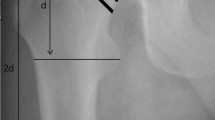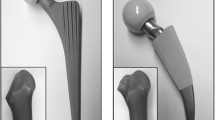Abstract
Introduction
Short femoral hip stems with a metaphyseal anchoring concept have been designed to treat younger patients with good bone quality. The aim of this study was to reconstruct the centre of rotation and soft tissue balancing and preserve bone in the long-term perspective.
Materials and methods
Eighteen human femurs were randomised into three groups: (1) metaphyseal anchoring short stem, (2) shortened straight stem, (3) straight stem). Prior to the implantation of the hip stems, a computed tomography (CT) of the bones was performed and the femoral ante-torsion and ante-tilt was measured and compared to the results of the post-implantation CT. This could be calculated based on the 3D coordinates taken from the pre- and post-op CT scans, which were transformed into the same coordinate systems.
Results
The mean preoperative caput–collum–diaphyseal (CCD) angle for the three groups was 126.87° ± 3.50° (Group 3: 129.64° ± 3.53°, Group 1: 123.76° ± 5.56°, Group 2: 127.53° ± 1.42°) and was consistent with published reports. The postoperative CCD angles with 126.85° ± 3.43° were within a very good reconstruction range for all three groups.
The anterior offset comparison among these three groups showed significant difference in reconstruction. The smallest difference between the anatomical (preoperative) and postoperative condition was seen in Group 1 (1.47° ± 0.60°), followed by Group 2 (3.60° ± 0.23°) and Group 3 (8.00° ± 0.70°) groups. The horizontal offset showed no significant difference among the groups and was within the window of ± 5 mm.
Conclusion
In this cadaver study, we found that the metaphyseal anchoring, partially neck-preserving short hip stem best reconstructs the ante-torsion and the ante-tilt of the femoral neck. Therefore, it can be a useful stem in younger or active middle-aged patients.





Similar content being viewed by others
References
Swedish Arthroplasty Register (2017) https://registercentrum.blob.core.windows.net/shpr/r/Eng_Arsrapport_2017_Hoftprotes_final-Syx2fJPhMN.pdf. Accessed 26 Jun 2020
Kim YH, Park JW, Kim JS (2018) Short-term results of ultra-short anatomic vs ultra-short non-anatomic proximal loading uncemented femoral stems. J Arthroplasty 33(1):e149–e155
Capone A, Bienati F, Torchia S et al (2017) Short stem total hip arthroplasty for osteonecrosis of the femoral head in patients 60 years or younger: a 3- to 10-year follow-up study. BMC Musculoskeletal Disord 18:301
Choi YW, Kim SG (2016) The short-term clinical outcome of total hip arthroplasty using short metaphyseal loading femoral stem. Hip Pelvis 28(2):82–89
Stulberg SD, Patel RM (2013) The short stem: promises and pitfalls. Bone Joint J 95B(Supplement A):57–62
Schnurr C, Schellen B, Dargel J et al (2017) Low short-stem revision rates: 1–11-year results from 1888 total hip arthroplasties. J Arthroplast 32:487–493
Gronewold J, Berner S, Olender G et al (2014) Changes in strain patterns after implantation of a short stem with metaphyseal anchorage compared to a standard stem: an experimental study in synthetic bone. Orthop Rev (Pavia) 6(1):5211
Bieger R, Ignatius A, Decking R et al (2012) Primary stability and strain distribution of cementless hip stems as a function of implant design. Clin Biomech (Bristol, Avon) 27(2):158–164
Hochreiter J, Hejkrlik W, Emmanuel K et al (2017) Blood loss and transfusion rate in short stem hip arthroplasty. A comparative study. Int Orthop 41(7):1347–1353
Windhagen H, Chincisan A, Choi HF et al (2015) Soft tissue balance in short and straight stem total hip arthroplasty. Orthopedics 38(3 Suppl):14–20
Zimmerer A, Slouka S, Kinkel S et al (2020) Comparison of short-stem with conventional-stem prostheses in total hip arthroplasty: an 8-year follow-up study. Arch Orthop Trauma Surg 140(9):1285–1291
Klasan A, Bäumlein M, Dworschak P et al (2019) Short stems have lower load at failure than double-wedged stems in a cadaveric cementless fracture model. Bone Jt Res 8(10):472–480
Jahnke A, Wiesmair AK, Fonseca Ulloa CA et al (2020) Outcome of short- to medium-term migration analysis of a cementless short stem total hip arthroplasty using EBRA-FCA: a radiological and clinical study. Arch Orthop Trauma Surg 140(2):247–253
van Oldenrijk J, Molleman J, Klaver M et al (2014) Revision rate after short-stem total hip arthroplasty: a systematic review of 49 studies. Acta Orthop 85(3):250–258
Yan SG, Weber P, Steinbrück A et al (2018) Periprosthetic bone remodelling of short-stem total hip arthroplasty: a systematic review. Int Orthop 42(9):2077–2086
Shoji T, Yasunaga Y, Yamasaki T et al (2015) Low femoral antetorsion and total hip arthroplasty: a risk factor. Int Orthop 39(1):7–12
Lachiewicz PF, Soileau ES (2013) Low early and late dislocation rates with 36- and 40-mm heads in patients at high risk for dislocation. Clin Orthop Relat Res 471(2):439–443
Reina N, Pareek A, Krych AJ et al (2019) Dual-mobility constructs in primary and revision total hip arthroplasty: a systematic review of comparative studies. J Arthroplast 34(3):594–603
Widmer KH, Zurfluh B (2004) Compliant positioning of total hip components for optimal range of motion. J Orthop Res 22(4):815–821
Ranawat CS, Maynard MJ (1991) Modern techniques of cemented total hip arthroplasty. Tech Orthop 6:17–25
Mihalko WM, Assaf D, Sungu M (2015) Reproducing the hip center with a femoral neck-retaining implant. Orthopedics 38(3 Suppl):21–26
Afghanyar Y, Danckwardt C, Schwieger M et al (2020) Primary stability of calcar-guided short-stem total hip arthroplasty in the treatment of osteonecrosis of the femoral head: migration analysis using EBRA-FCA. Arch Orthop Trauma Surg 140(12):2091–2100
Acknowledgements
None declared.
Funding
This study was financed by Aesculap AG and has not been presented in any conference before.
Author information
Authors and Affiliations
Corresponding author
Ethics declarations
Conflict of interest
Authors ME, SB, and HW received grants from Aesculap AG, Tuttlingen, Germany, where they are medical consultants. Author MS is an engineer and employee at Aesculap AG, Tuttlingen, Germany. Authors MM and NW have no conflict of interest to declare.
Ethical approval
This article describes a cadaveric study and does not contain any studies/experiments on live human subjects or animals.
Informed consent
This article does not contain any studies with human participants and hence, no informed consent was required from individual participants.
Additional information
Publisher's Note
Springer Nature remains neutral with regard to jurisdictional claims in published maps and institutional affiliations.
Rights and permissions
About this article
Cite this article
Ezechieli, M., Windhagen, H., Matsubara, M. et al. A neck-preserving short stem better reconstructs the centre of rotation than straight stems: a computed tomography-based cadaver study. Arch Orthop Trauma Surg 142, 1669–1680 (2022). https://doi.org/10.1007/s00402-021-03957-2
Received:
Accepted:
Published:
Issue Date:
DOI: https://doi.org/10.1007/s00402-021-03957-2




